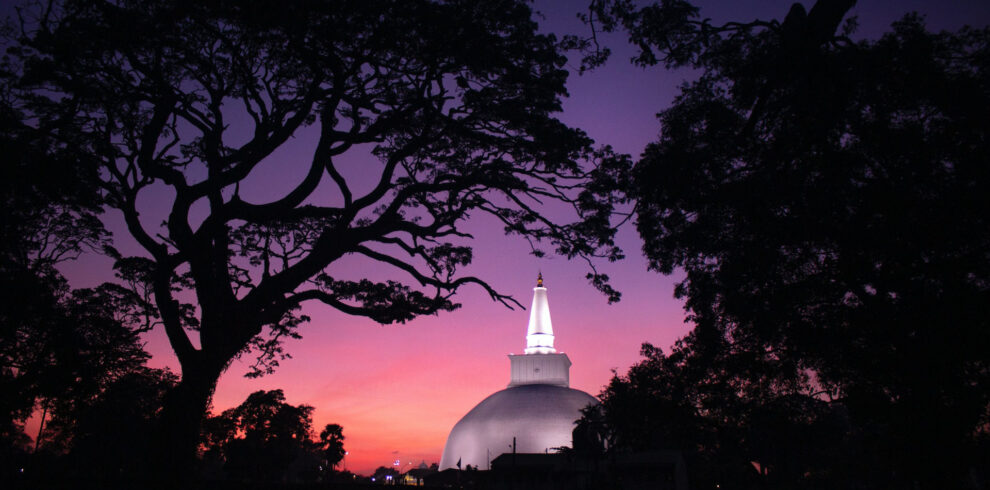Overview
Anuradhapura, a Ceylonese political and religious capital that flourished for 1,300 years, was abandoned after an invasion in 993. Hidden away in dense jungle for many years, the splendid site, with its palaces, monasteries and monuments, is now accessible once again.
Jaya Sri Maha Bodhi -Jaya Sri Maha Bodhi which is the Sacred Bo Tree – this is the tree of the sapling of the Sacred Bodhi brought by Sanghamitta, daughter of Emperor Ashoka from the main stem of the Bodhi Tree in India under which Lord Buddha obtained enlightenment. This sapling was received by King Devanampia Tissa who had then planted it ceremoniously at this present site.
Lovamahapaya – Lovamahapaya or Brazen Palace which is a building of nine storeys framed with stone pillars that were built by King Dutugemunu. This structure was named ‘Brazen Palace’ because it had a copper or bronze tiled roof. The purpose of this palace was to house 1000 monks and attendants by providing shelter, nursing care and facilities for the injured.
Ruwanwelisaya Dagoba – Ruwanwelisaya Dagoba which is the oldest stupa in Sri Lanka. Ruwanwelisaya is considered an icon of architectural glory in ancient Sri Lanka. Also known as the Great Stupa, Ruwanwelisaya was built by the victorious King Dutugemunu in 140 BC. It was his ambitious project and this stupa bears witness for its unparalleled service to revive Buddhism in the country.
Tissa Wewa – Tissa Wewa, an artificial reservoir built by King Devanampiya Tissa in the 3rd century BC in order to provide and increase water supply to the city of Anuradhapura and to supply water to the king’s royal gardens. This reservoir was then expanded and integrated into a network of canals for irrigation.
Miriswatiya Dagoba – Miriswatiya Dagoba which was the first monument built by King Dutugemunu. After his consecration, an ornate sword which contained a sacred relic of Buddha was left implanted on the bank on the seventh day of the water festival at the Tissa Wewa. Upon returning after his bath at the reservoir, the king couldn’t take out his sword after several attempts which led them to believe that it was a miracle, hence the building of this dagoba on this location around the sword.
Thuparama Temple – Thuparama Temple. It is the oldest stupa in Sri Lanka and the first to be built in the country after the introduction of Buddhism. It was built by King Devanampiya Tissa. The Thuparama stupa is considered to be the smallest stupa in the island and probably in the world. It is sacred to the Buddhists for it is known to house the right collarbone relic of Lord Buddha which was brought to Sri Lanka by Mahinda, son of King Ashoka of India.
Moonstone – Moonstone which is within the Abayagiri Monastery and is found at the main flight of stairs on the centre building. This moonstone is considered one of the best and most preserved arts from this era dating back to the 7th-8th centuries. Then you can see the Guardstone. The Rathna Prasada was once the largest building in the Abhayagiriyi monastery which was destroyed during the South Indian invasions. Over the years, the successive kings were able to protect and preserve some ruins, of which one is an exquisitely carved guard stone which portrays a god king protected by a five headed cobra (Naga Gala) holding a vase with flowers reflecting prosperity.
Abhayagiri Monastery Complex – Abhayagiri Monastery Complex which is the largest monastery complex in the Anuradhapura kingdom built by a Sinhalese King called Vattagamini Abhaya. This complex includes Abhayagiri Stupa, it is the main stupa constructed over a footprint of Lord Buddha. A part of the Sri Maha Bodhi tree is also there. The stupa was 370 feet tall when originally built and it was the second tallest stupa in the island. The new museum at Abhayagiri Monastery was established in memory of Fa-hsien to preserve and exhibit the treasures discovered during the excavations which were ornaments and jewellery made of gold and with gems and crystals. This museum was also initiated to keep all archaeological treasures and artefacts that have been excavated through archaeological explorations.
Samadhi Buddha Statue – Samadhi Buddha Statue which is a classic monument of Sinhalese art and sculpture. It stands tall at 2 metres and is a granite stone carving erected in a position of meditation (Samadhi) which was associated with Buddha’s first enlightenment and is one of the four Buddha statues that was placed around the Bodhi tree facing fundamental directions.
Jetavaranama Stupa – Jetavaranama Stupa and monastery built in the 3rd century, the magnificent Jetavaranama stupa was the largest brick structure in the world and the third largest structure of any type. Consisting of over 90 million bricks, this enormous bulbous stupa can get one be reflective and connect to its past with emotions of calm and serenity. Therefore it is well worth the visit for the scale of its structure shows the feat and determination at the time. Around it stand the ruins of a monastery that had housed 3000 monks.
Kuttam Pokuna, Kuttam Pokuna known as the ‘Twin Ponds. It is an architectural landscape built to be a bathing pool with terraces for the monks and it dates back to the 8th century.
Aukana Buddha Statue – Aukana Buddha Statue holds prestige in the historical chronicles as being one of the tallest standing statues of Buddha in Sri Lanka. The fine sculpture of the Buddha statue gives credit to the artistry and skill of the craftsmen since this colossal statue stands at a mighty height of 42 feet.
TAKE A TOUR OF THE FOLLOWING LOCATIONS
- Jaya Sri Maha Bodhi
- Lovamahapaya
- Ruwanwelisaya Dagoba
- Jetavaranama Stupa
- Tissa Wewa
- Miriswatiya Dagoba
- Thuparama Temple
- Aukana Buddha Statue
- Abhayagiri Monastery Complex
- Jetavaranama Stupa
- Moonstone
- Kuttam Pokuna
- Samadhi Buddha Statue





